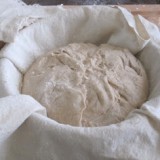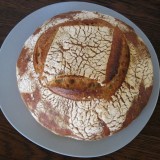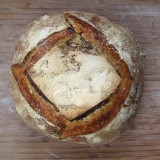
I used to make my own beer. But after three ruined batches and not wanting to add to a growing middle-aged paunch, I decided to give away the equipment. One thing I miss is not being able to make bread with the leftover grains.
That is, until I tried a recipe from Emmanuel Hadjiandreou’s book How to Make Sourdough. Hadjiandreou, a specialist in Northern European breads, taught me that you can skip the beer making and just use malted grains directly in your bread.

The grains used in making beer are, mostly, barley that has been malted (sprouted) and then either caramelized or roasted. To make beer you soak the grains in warm water to extract the sugars that form in the malting process. Fermenting that sugary malt water creates alcohol. Most of the grain used to make beer is two or six-row malt. You add so-called “specialty” grains (that have been caramelized or roasted) to add flavor. If you skip the beer making and add the specialty malts directly to your dough, more of their flavor makes it into the bread.
Step into a homebrew shop and you’ll find bin after bin of different specialty grains. I decided, with Hadjiandreou’s advice to start with three: a crystal malt (I used a caramel 120), a plain malt (such as Maris Otter) and an American chocolate malt. But you don’t need to use these exact grains. Stick your head in the grain bins and let your nose lead you.
In a 2-pound sourdough rye loaf Hadjiandreou’s recipe calls for 20 grams of chocolate malt and 40 grams each of the other two grains. A lighter hand with the dark malts will reduce the chance of bitter bread.
To soak or not to soak
Usually when I add whole grains or seeds to bread I like to soak them for a few hours in hot water. But when I tried this with the specialty grains I ended up inadvertently starting the beer making process. Much of the syrupy goodness flowed out the grain and was lost when I had to drain it prior to adding it to my dough. Instead, I got better results by starting with a wet dough and letting the grain soften during a very long bulk fermentation and proof. An important last step was to put a bowl over the loaf after it came out of the oven to lock in the moisture. I would never do this with most kinds of bread, but this style of dense German/Scandinavian bread really benefits from a wet post-bake sauna. In addition to further softening the specialty grain it also softens the crust.
While I may no longer make beer, I can still make what I like to call “solid” beer: a.k.a. bread. And with the many varieties of specialty grain, a whole world of flavor awaits.





Anytime I feel stressed about money I bake bread. Its filling and comforting and if you know there is hot bread at home you have much less urge to give in to the call of mcdonalds. My childs childhood memories will always smell if moms homemade bread. Its his favorite thing. He doesnt know it means mommy is anxious and wants to make sure his belly is full. He only knows it smells like love.
What a beautiful loaf. Yum!